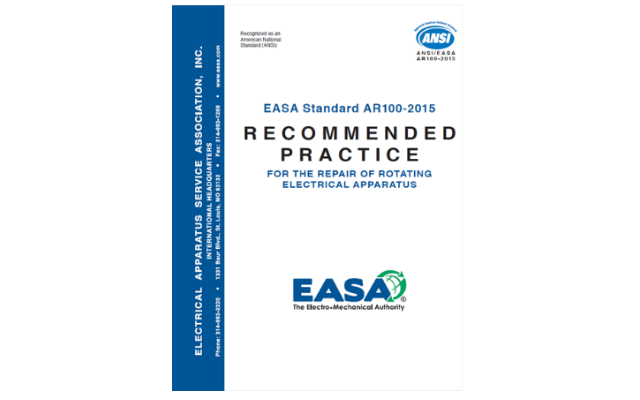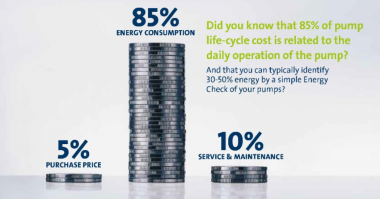Author: William C. Livoti
I will begin this article with a few thought-provoking questions:
- What methodologies / practices / procedures do you have in place to insure a quality motor repair?
- When you send a motor (out of warranty) in for a rewind do you verify that the motor is at the very minimum rewound to OEM specification?
- Do you have a procedure for qualifying your motor repair shop(s)?
- Do you perform vendor surveillance?
- Do you require rewound motors to be dyno tested prior to installation? Do you witness the dyno test?
- When you send a motor in for OEM warranty repair do you verify that the motor is returned to OEM specifications?
If you answered yes to all the above questions, you have you motor repair program well under control. However, you may find this article enlightening, so please read on. Those of you that answered no to any or all the questions will find this article beneficial to your motor reliability program. We will discuss each question in this article.
Repair or Replace
Repair or replacement of a motor is not as straight forward as some may believe; there are several factors to be considered. For the purposes of this article, let’s limit the discussion to “Standard” NEMA motors. A motor failure / burnout produces two alternatives: Rewind the failed motor OR Purchase a new motor. However, as I stated earlier Re-wind vs Replace depends on such variables as the re-wind cost, expected rewind loss (yes, there are losses), energy-efficient (EISA) motor purchase price, motor horsepower and efficiency, load factor, annual operating hours, electricity price, simple payback criteria – and here’s another variable, will the replacement EISA motor fit on the existing foot print? At least some of the time, re-winding will be the best decision. The prospects for a good re-wind are greatly improved if you keep good records on your motors and provide them to the repair shop. Repair shops often can’t get complete specifications from manufacturers. The repair shop must “reverse engineer” motors; this process involves counting winding turns, noting slot patterns, measuring wire size, etc., before removing old windings. Sometimes a motor has failed repeatedly in the past because of a previous non-standard re-wind. This may require significant investigation as to the root cause of the failure / repair. This also raises another issue: how do you return the motor to OEM specification?
Communication and Teamwork
The same error can be repeated unless the shop knows the motor is a “repeat offender” and diagnoses the problem. Similarly, a motor is sometimes subjected to unusual service requirements, e.g., frequent starts, dirty environment, low voltage. The key here is communication between the End User Team and the motor repair shop to make sure the application is well understood.
Did You Know?
Motor efficiency losses after re-winds also vary considerably. While dynamometer tests conducted by the Electrical Apparatus Service Association (EASA) indicate that new motors, when properly stripped and re-wound, can be restored to their original efficiency, field tests on motors from a variety of manufacturing plants indicate that losses are typically higher in motors that have been re-wound; perhaps because of thermal shock suffered during the motor failure.
An analysis of core loss tests taken over a 1-year period in a major motor OEM’s repair facility indicated that average core losses are 32% higher than normal for motors that had been previously re-wound. The same OEM also conducted a test of 27 re-wound motors in the 3- to 150-hp size range. The test indicates that total losses increased by 18% for motors that have been re-wound compared to those that have not been re-wound. Impact of an 18% loss: An 18% increase in losses corresponds to an approximate 1.5 to 2.5 percent decrease in full-load efficiency (think energy efficiency). Here’s something else to consider: re-wound motors can exhibit severe efficiency losses, especially if they were re-wound more than 15 years ago or have been re-wound several times. Re-wind losses of 5% or more are possible.
Rule of Thumb – Rewind or Replace
A general rule of thumb when evaluating a motor for rewind: if the cost of the re-wind (returning motor to OEM specifications) exceeds 65% of a new energy-efficient motor price, buy a new motor. Increased reliability and efficiency should quickly recover the price premium (assuming the system is operated efficiently).
A few additional factors to consider when evaluating a rewind vs replace:
- Delivery Time – Is this a special motor with unique features?
- Foot Print – EISA vs existing motor frame size
- Custom Configuration – Specialty motor
- Motor Inrush – EISA can be as much as 13x FLA due to high X/R ratio Vs 600 to 700% for EPAct (Energy Policy Act of 1992)
- Reduced Slip – EISA motor has less slip (system implications)
Disclaimer: As motor design characteristics (such as slot geometry and configuration), failure modes, re-wind practices, and materials specifications and treatments vary, it is impossible to identify a “typical” re-wind cost for a motor with a given horsepower, speed, and enclosure.
Repair Strategy
As an End User / Equipment Owner, what procedures can you implement to insure a quality repair / rewind? Let’s begin by revisiting the (6) questions from the beginning of this article.
To guarantee a quality repair, one must have in place:
- A QA/QC program and/or procedure to address both warranty and non-warranty repair / rewinds
- Vendor qualification / audit program
- Vendor Surveillance
- Motor performance testing (Dyno Test)
Please understand that there is no “Standard” for a motor rewind. EASA has a recommended best practice standard for the repair of motors: EASA Standard AR100-2015; however, because there is no legal requirement, vendors can circumvent the procedures defined by such a trusted authority as EASA. I have personally experienced this in motor repairs as well as pump repair and installation procedures.
Therefore, the only way you the End User / Equipment Owner can protect yourself is to implement a repair strategy that incorporates EASA AR100-2015 along with clarifying specifications and criteria during the repair / rewind and testing process.
Vendor Selection Process
 A quality motor repair program begins with a vendor qualification process. Vendor qualification should begin with a phone call / interview with the appropriate party at the motor repair facility, this is a prequalification step. This prequalification should be followed up with a questioner (Motor Repair Vendor Capability Survey) to further qualify the prospective motor repair facility. Having successfully completed the prequalification phase, the next step is a site visit, at which time the facility and staff are audited. The expertise, professionalism, and overall quality offered by electric motor repair facilities can vary significantly from shop to shop — and over time.
A quality motor repair program begins with a vendor qualification process. Vendor qualification should begin with a phone call / interview with the appropriate party at the motor repair facility, this is a prequalification step. This prequalification should be followed up with a questioner (Motor Repair Vendor Capability Survey) to further qualify the prospective motor repair facility. Having successfully completed the prequalification phase, the next step is a site visit, at which time the facility and staff are audited. The expertise, professionalism, and overall quality offered by electric motor repair facilities can vary significantly from shop to shop — and over time.
Quality repair shops share many of the same characteristics.
When choosing a motor repair shop, look for the following:
- Maintains clean, orderly work areas and has a stable workforce of well-trained, technically proficient employees.
-
- Fully equipped with state-of-the-art test equipment and instruments. Quality shops will calibrate their instruments annually to National Institute of Standards and Technology (or equivalent) standards to ensure the accuracy of repair readings and measurements.
-
- Adheres to a documented set of repair procedures. High-quality motor shops are procedure driven and never rely solely on the skills and experience of shop technicians. These providers have developed detailed procedures covering electric motor repairs and document each step of the repair process. This helps ensure your motors are repaired or rebuilt to documented mechanical and electrical standards every time, regardless of when repairs are made or who made them.
-
- Use high-quality replacement components procured through transparent supply channels. This alleviates customer concerns about obsolete or counterfeit components that may result in poor motor performance. More on this issue in a future article.
In addition to the practices and procedures as outlined above the audit process should also include:
-
- Work orders and processes
- Quality control
- Equipment calibration
- Storage of consumables
- Work in progress and serviced motors
- Motor assembly/disassembly procedures
- Re-certification of technicians (one to two years)
- Machining practices
- Tools and instrumentation
- Lubrication practices
- Cleanliness and housekeeping
- Mechanical and electrical motor conformance testing
- Correct shipping procedures
Among other actions, the procedures followed by high-quality shops include conducting a stator core test before and after winding removal, as well as confirming that the core has not been damaged during the repair process. Core loss testing and “hot-spot” testing is vital when it comes to determining the condition of the AC induction motor stator iron integrity. Operational costs and long-term stator winding reliability are the primary considerations. Core losses decrease the efficiency of electric motors and can increase a plant’s utility costs. Leading motor shops spend considerable time and resources on electrical and mechanical acceptance testing. However, state-of-the-art acceptance testing requires a significant investment in test instruments, but is highly recommended as a way of detecting problems before the motor leaves the shop and is returned to service.
Electrical and Mechanical Acceptance Procedures
Electrical acceptance procedures include:
- Insulation resistance (IR) testing
- High-potential testing
- Stator winding resistance imbalance
- Polarization index (PI), step voltage, and surge testing.
Mechanical acceptance procedures include:
- Vibration spectrum analysis (Use API Standards)
- Shaft end runout (meet OEM specification)
- Soft foot testing (reference API 686 for allowable tolerance)
- Rotor balancing – Rotor balancing should reference an ISO balance grade to ensure established balancing standard. The rotor balance should match the balance specification of the drive component.
Why is it so important to develop and agree to a motor repair specification? We will dive into this in Part 2 of this 3-Part Series.
Electric Motor Repair: How to Manage a Motor Rewind Shop (Part 2)





I had no idea that motor efficiency losses vary considerably after re-winds, and that makes sense considering one should always make an effort to maintain a motor. My dad was talking about electric motors the other day, and how his life dream has always been to focus on either fixing or manufacturing motors but never go around to do it. In my opinion, it is never too late to focus on a hobby, and he should look online to find the equipment and tools that he would need.
It’s helpful to know that finding out the supply channels for replacement components can help me know they’re good quality. My brother and I have been working on rebuilding a generator our dad left to us, and we’re thinking of bringing the motor itself in to have a professional work on it. We’ll be sure to ask about their process so we can know we can trust it to work well.